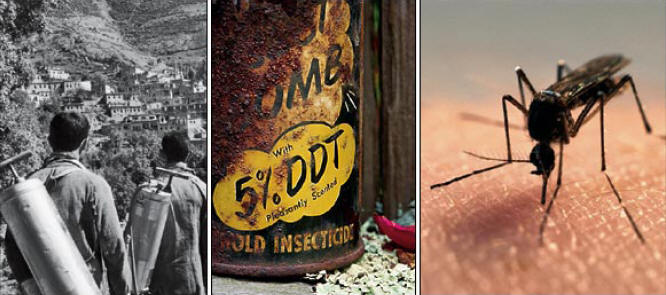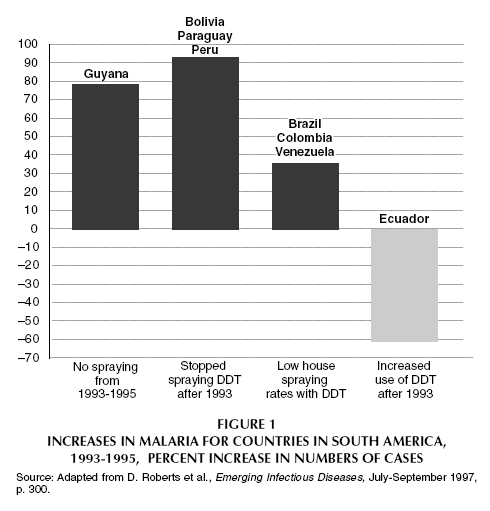|
|
|
from NewYorkTimes Website
Above left: With equipment provided by Unicef, a 1960 DDT team prepared to go house to house in Masuleh, Iran. Center: DDT was an insecticide of choice in the United States. Then, in 1962, came Rachel Carson's "Silent Spring." Right: A female mosquito, needing blood to nourish her eggs, sucks away with her probiscus.
The year 2000 was a time of plague for the South African town of Ndumo, on the border of Mozambique. That March, while the world was focused on AIDS, more than 7,000 people came to the local health clinic with malaria.
The South African Defense Force was called in, and soldiers set up tents outside the clinic to treat the sick.
At the district hospital 30 miles away in Mosvold, the wards filled with patients suffering with the headache, weakness and fever of malaria - 2,303 patients that month.
Today, malaria has all but vanished in
Ndumo. In March 2003, the clinic treated nine malaria cases; Mosvold
Hospital, only three.
Several insecticides can be used, but South Africa has chosen the most effective one.
KwaZulu-Natal, the province of South Africa where Ndumo and Mosvold are located, sprayed with DDT until 1996, then stopped, in part under pressure from other nations, and switched to another insecticide.
But mosquitoes proved to be resistant to the new insecticide, and malaria cases soared. Since DDT was brought back in 2000, malaria is once again under control.
To South Africans, DDT is their best
defense against a killer disease.
Its persistence in the ecosystem, where
it builds up to kill birds and fish, has become a symbol of the
dangers of playing God with nature, an icon of human
It is that dozens more do not. Malaria is a disease Westerners no longer have to think about. Independent malariologists believe it kills two million people a year, mainly children under 5 and 90 percent of them in Africa. Until it was overtaken by AIDS in 1999, it was Africa's leading killer.
One in 20 African children dies of malaria, and many of those who survive are brain-damaged. Each year, 300 to 500 million people worldwide get malaria. During the rainy season in some parts of Africa, entire villages of people lie in bed, shivering with fever, too weak to stand or eat.
Many spend a good part of the year incapacitated, which cripples African economies.
A commission of the World Health
Organization found that malaria alone shrinks the economy in
countries where it is most endemic by 20 percent over 15 years.
There is currently no vaccine. While travelers to malarial regions
can take prophylactic medicines, these drugs are too toxic for
long-term use for residents.
The paradox is that sprayed in tiny quantities inside houses - the only way anyone proposes to use it today - DDT is most likely not harmful to people or the environment.
Certainly, the possible harm from DDT is
vastly outweighed by its ability to save children's lives.
But at the moment, there is only one country in the world getting donor money to finance the use of DDT: Eritrea, which gets money for its program from the World Bank with the understanding that it will look for alternatives.
Major donors, including the United
States Agency for International Development, or
USAID, have not financed any use of
DDT, and global health institutions like
W.H.O.
and its malaria program, Roll Back Malaria, actively
discourage countries from using it.
If around 80 percent of houses are
covered, spraying protects everyone, as the bites that take place
will be from mosquitoes less likely to have bitten an infected
person. But house spraying is only effective against mosquitoes that
bite indoors - not all do. It also requires a government capable of
organizing, training and equipping sprayers, which is beyond the
reach of some countries.
But they have significant limitations, and one reason malaria has surged is that they have essentially become the only tool promoted by Western donors.
The other reason DDT has fallen into disuse is wealthy countries' fear of a double standard.
Given the malignant history of American companies employing dangerous drugs and pesticides overseas that they would not or could not use at home, it is understandable why Washington officials say it would be hypocritical to finance DDT in poor nations.
But children sick with malaria might
perceive a more deadly hypocrisy in our failure to do so: America
and Europe used DDT irresponsibly to wipe out malaria. Once we
discovered it was harming the ecosystem, we made even its safe use
impossible for far poorer and sicker nations.
Malaria no longer afflicts the United
States, Canada and Northern Europe in part because of changes in
living habits - the shift to cities, better sanitation, window
screens. But another major reason was DDT, sprayed from airplanes
over American cities and towns while children played outside.
When it started, India was losing
800,000 people every year to malaria. By the late 1960's, deaths in
India were approaching zero. In Sri Lanka, then called Ceylon, 2.8
million cases of malaria per year fell to 17. In 1970, the National
Academy of Sciences wrote in a report that ''to only a few chemicals
does man owe as great a debt as to DDT'' and credited the
insecticide, perhaps with some exaggeration, with saving half a
billion lives.
But eradication failed - it is now
considered biologically impossible - and because DDT had not lived
up to its billing, disillusion set in. At the same time, DDT's
indiscriminate use was provoking the development of resistance among
mosquitoes, and many countries were shifting to decentralized health
systems, which meant they were no longer able to organize nationwide
house spraying.
Donald Roberts, a professor at the Uniformed Services University of the Health Sciences in Bethesda, Md., has argued that when Latin America stopped using DDT in the 1980's, malaria immediately rose, leading to more than a million extra cases a year.
The one country that continued to beat malaria was Ecuador, the one country that kept using DDT.
In the few countries where it is used today, DDT is no longer sprayed from airplanes, and no country admits to using it as an insecticide for crops - although there are probably cases where it is diverted for agricultural use. Its only legitimate use is inside houses.
Roberts said that the quantities used for house spraying are so small that Guyana, to take one example, could protect every single citizen of its malarious zones with the same amount of DDT once used to spray 1,000 acres of cotton.
What about DDT's impact on the people inside the houses?
The most serious evidence of DDT's harm to humans are a few studies showing that higher levels of DDE (the form DDT takes when it metabolizes) in a mother's blood is associated with premature birth and shorter duration of breast-feeding.
But other studies have found no such associations. There was suspicion that DDT causes breast cancer, but study after study has found no connection.
In general, DDT is feared for its effect
on the environment, not on humans. It has been used on such a huge
scale over the last 50 years that it is reasonable to think that if
it had any serious effect on human health, we would know it by now.
''Silent Spring'' for the first time caused Americans to question the scientists and officials who had been assuring them that no harm would result from the rain of pesticides falling on their farms, parks and backyards.
Carson detailed how DDT travels up the
food chain in greater and greater concentrations, how robins died
when they ate earthworms exposed to DDT, how DDT doomed eagle young
to an early death, how salmon died because DDT had killed the stream
insects they ate, how fiddler crabs collapsed in convulsions in
tidal marshes sprayed with DDT.
Public opinion is so firm on DDT that even officials who know it can be employed safely dare not recommend its use.
Anne Peterson, the USAID official, explained that part of the reason her agency doesn't finance DDT is that doing so would require a battle for public opinion.
Because the ban on DDT became the midwife to the environmental movement, the debate about it, even today, is bizarrely polarized.
Most environmental groups don't object
to DDT where it is used appropriately and is necessary to fight
malaria. But liberals still tend to consider it a symbol of the
Frankenstein effects of unbridled faith in technology. For
conservatives, whose Web sites foam at the mouth about the hypocrisy
of environmentalists, DDT continues to represent the victory of
overzealous regulators and Luddites who misread and distort science.
It remains one of the most controversial
decisions the E.P.A. has ever taken. Ruckelshaus was under a storm
of pressure to ban DDT. But Judge Edmund Sweeney, who ran the
E.P.A.'s hearings on DDT, concluded that DDT was not hazardous to
humans and could be used in ways that did not harm wildlife.
Ruckelshaus banned it anyway, for all but emergencies.
There was no malaria in the United States - in part thanks to DDT - so there were no public health benefits from its use.
In fact, we are - the central reason that African nations who need DDT do not use it today.
Washington is the major donor to W.H.O. and Roll Back Malaria, and most of the rest of the financing for those groups comes from Europe, where DDT is also banned. There is no law that says if America cannot use DDT then neither can Mozambique, but that's how it works. The ban in America and other wealthy countries has, first of all, turned poor nations' agricultural sectors against DDT for economic reasons.
A shipment of Zimbabwean tobacco, for
example, was blocked from entering the United States market because
it contained traces of DDT, turning Zimbabwe's powerful tobacco
farmers into an effective anti-DDT lobby. From a health point of
view, of course, American outrage would have been more appropriate
if traces of tobacco had been found in their DDT than the other way
around.
The question is amusing, because the corporate interests in this issue are actually on the other side.
DDT is no longer on patent, and it is known to be made only in India and China - and the price has soared since the rich-country ban put manufacturers out of business, making it harder for poor countries to buy.
Janet Hemingway of the Liverpool School, who advises African governments, said that she and the officials she works with are often lobbied by chemical companies selling more expensive insecticides, telling her about DDT's evils.
But more important to DDT's demise has been pressure from the international malaria establishment.
Sometimes it is direct. Mexico gave up
DDT, for example, because the North American Free Trade Agreement
obligated it to. Donald Roberts, who was working in Belize in
the early 1990's, said that USAID told the country to stop using DDT
or it would lose foreign assistance. (Belize did, and malaria
rates soared...)
It banned nine outright. For DDT, the
treaty allowed its use in indoor spraying for public health
purposes, but called for its gradual phase-out. DDT's exemption,
which had been opposed by environmental groups but supported by
malariologists, did allow countries dependent on DDT to continue to
use it for the present. But Stockholm's guiding principle - phase it
out - is one more factor that discourages donors from financing DDT.
The Global Fund to Fight AIDS, Tuberculosis and Malaria - which uses guidelines set by W.H.O. - currently finances no DDT.
Vinand Nantulya, senior adviser to the fund's executive director, said that the fund might theoretically supply DDT to a country that requests it - but none have. This is no surprise: these countries work closely with W.H.O. and advisers from USAID to formulate their proposals to the Global Fund, and they are unlikely to ask for things that stand a low chance of approval.
Many African scientists and health officials report being told by donors,
The balance of power is so tilted toward
the donors in these relationships that poor countries will go quite
far out of their way to not offend. DDT is controversial; better not
to ask.
In a document explaining its decision, the bank said,
Renato Gusm-o of
P.A.H.O.
said that the bank's environmental group told him it was
fighting for the elimination of DDT and could not allow the bank to
finance DDT while advocating a ban.
Malaria cases more than doubled.
The 1980's and 1990's also saw the rise of environmental units within the health institutions and donors like the World Bank. These watchdog units were much needed and in general have been a crucial tool to protect the environment. But they look at only the risks, not the benefits.
Walter Vergara, the World Bank official who headed the unit that dismissed DDT in Ecuador, defended the decision to me:
Said David Brandling-Bennett, the former deputy director:
When Lee Jong-Wook became head of
W.H.O. last year, he wrote an article for The Lancet, the
British medical journal, setting out his vision. Lee wrote about
AIDS, about SARS, about strengthening public health systems. He did
not mention malaria.
That has made one of Africa's leading killers shockingly invisible.
Lawrence Barat, the World Bank's adviser on malaria control, said,
One of the most depressing aspects of talking about malaria is that you get to hear the phrase ''the powerful AIDS lobby,'' a term no one but a malariologist would use.
AIDS in the third world is still
criminally underfinanced, but at least it gets some money and a lot
of attention. Malaria gets AIDS's dregs. AIDS was a sudden plague,
very visible in its choice of victims, and it has a vocal
constituency in rich countries. Even in Africa, malaria gets nowhere
near the attention of AIDS. It has always been around, and it kills
not middle-class adults but rural 4-year-olds, who don't have much
of a lobby.
In 2000, according to Amir Attaran,
a Massachusetts-based fellow of the
Royal Institute for International Affairs,
the 23 richest countries in the world plus the World Bank together
provided $100 million to fight malaria - less than a tenth of the
annual sum necessary to meet Roll Back Malaria's goals.
USAID, which in 1998 gave just $12
million to fight malaria, now gives $80 million a year, a notable
advance.
New, effective drugs are available, but they cost a minimum of 40 cents for a child's treatment and $1.50 for an adult's, which means that African governments - and therefore donors - will have to pay. Only a handful of Africa's 42 malaria-endemic countries have switched; one is South Africa, where the new drugs have been partly responsible for the country's recent success.
Those prices may not seem like much to
cure malaria, especially when contrasted with the hundreds of
dollars a year for life needed to treat AIDS. But 40 cents a child
is apparently too much for donors to provide.
And until nets with long-lasting
insecticide can be widely distributed, bed nets need regular
retreatment. It is insecticide that protects, not the net,
and the insecticide wears off without people knowing it.
Financing repeated rounds of spraying, donors argue, is not sustainable.
Mozambique is now doing house spraying successfully and cheaply without a national army of sprayers and a fleet of S.U.V.'s. Mozambique hires a few people in each community and gives them two weeks of training and the materials they need.
Those sprayers then walk from house to house, spraying each one twice a year.
Mozambique, because it depends on
Western donors, uses a more expensive insecticide. But if it used
DDT, it could protect people for $1.70 per person per year.
But malaria kills Africans today.
Those worried about the arrogance of playing God should realize that we have forged an instrument of salvation, and we choose to hide it under our robes.
|



 arrogance.
Countries throughout the world have signed a treaty promising to
phase out its use.
arrogance.
Countries throughout the world have signed a treaty promising to
phase out its use.